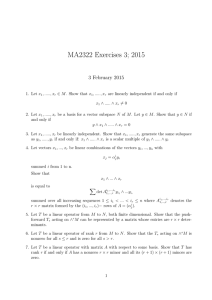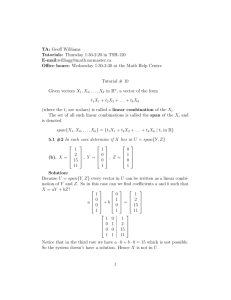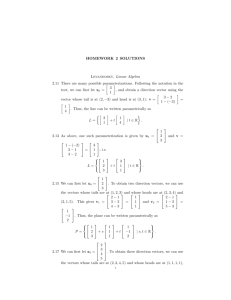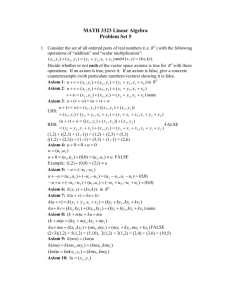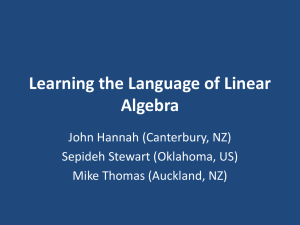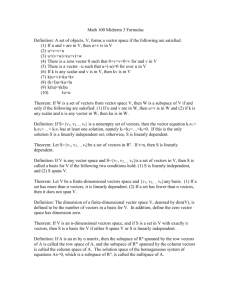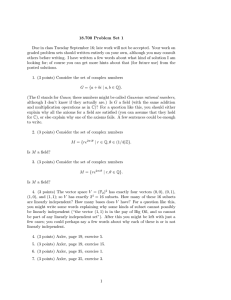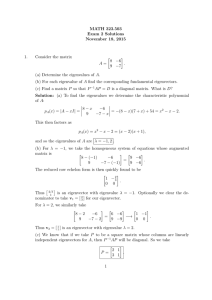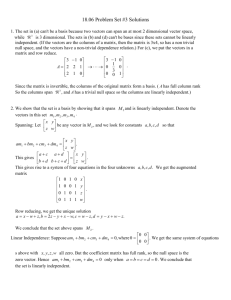MATH 3328 Differential Equations
advertisement
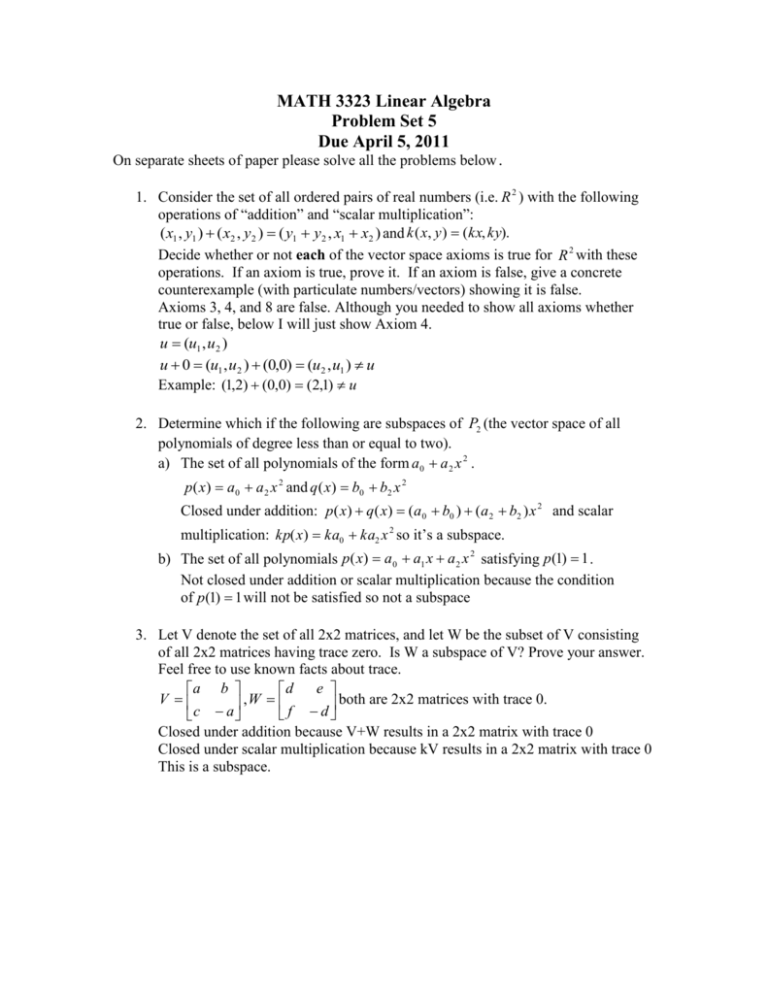
MATH 3323 Linear Algebra
Problem Set 5
Due April 5, 2011
On separate sheets of paper please solve all the problems below.
1. Consider the set of all ordered pairs of real numbers (i.e. R 2 ) with the following
operations of “addition” and “scalar multiplication”:
( x1 , y1 ) ( x2 , y2 ) ( y1 y2 , x1 x2 ) and k ( x, y ) (kx, ky).
Decide whether or not each of the vector space axioms is true for R 2 with these
operations. If an axiom is true, prove it. If an axiom is false, give a concrete
counterexample (with particulate numbers/vectors) showing it is false.
Axioms 3, 4, and 8 are false. Although you needed to show all axioms whether
true or false, below I will just show Axiom 4.
u (u1 , u 2 )
u 0 (u1 , u2 ) (0,0) (u2 , u1 ) u
Example: (1,2) (0,0) (2,1) u
2. Determine which if the following are subspaces of P2 (the vector space of all
polynomials of degree less than or equal to two).
a) The set of all polynomials of the form a 0 a 2 x 2 .
p ( x) a 0 a 2 x 2 and q ( x) b0 b2 x 2
Closed under addition: p( x) q( x) (a 0 b0 ) (a 2 b2 ) x 2 and scalar
multiplication: kp( x) ka0 ka2 x 2 so it’s a subspace.
b) The set of all polynomials p( x) a 0 a1 x a 2 x 2 satisfying p(1) 1 .
Not closed under addition or scalar multiplication because the condition
of p(1) 1 will not be satisfied so not a subspace
3. Let V denote the set of all 2x2 matrices, and let W be the subset of V consisting
of all 2x2 matrices having trace zero. Is W a subspace of V? Prove your answer.
Feel free to use known facts about trace.
e
a b
d
,W
V
both are 2x2 matrices with trace 0.
f d
c a
Closed under addition because V+W results in a 2x2 matrix with trace 0
Closed under scalar multiplication because kV results in a 2x2 matrix with trace 0
This is a subspace.
4. Show that vectors v1 (2,2,2) , v2 (0,0,3) and v3 (0,1,1) span R 3 , and express the
vector (1,2,0) as the linear combination of the three vectors.
2 0 0
A 2 0 1 , det( A) 6 0 so it spans R 3 .
2 3 1
k1v1 k 2 v2 k 3 v3 (1,2,0) , k1 1 / 2, k 2 2 / 3, k 3 3
5. Determine if the following are linearly independent subsets:
a) Determine whether or not vectors (1,-1,1,1), (3,0,1,1), (7,-1,2,1) form a
linearly independent subset of R 4 . Set up Ax=0 and solve.
1 3 7 0
1 3 7 0
1 0 1 0
0 3 6 0
1 1 2 0
0 2 5 0
1 1 1 0
0 0 1 0
k1 0, k 2 0, k 3 0 , therefore linearly independent
1 0
0 2
2 1
b) Let A
, B
, and C
. Do A, B, and C form
2 1
1 1
1 0
a linearly independent subset of M 2x 2 ?
1 0
0 2
2 1 0 0
k1
k2
k3
2 1
1 1
1 0 0 0
k1 2 k 3 0
2k 2 k 3 0
2 k1 k 2 k 3 0
k1 k 2 0
k1 0, k 2 0, k 3 0
c) Determine if 5, x 2 6 x, (3 x) 2 form a linearly independent subset
of F (, ) .
5 x 2 6 x (3 x) 2
W 0 2 x 6 2(3 x) 0 therefore linearly dependent
0
2
2
6. Are the following bases?
{(3,0,2), (-1,5,3), (2,-1,5)} in R 3 ?
3 1 2
A 0 5 1 , det( A) 66 0 so it spans R 3 and is linearly independent so it
2 3 5
is a basis.
{x 2 ,7 x} in P2 ? The dimension of P2 is 3 and we only have 2 terms so not a
basis.
{(1,-1), (-4,4)} in R 2 ? These vectors are multiples of each other so linearly
dependent therefore not a basis.
7. Determine the dimension of and basis for the solution space of the system:
x1 2 x 2 x3 0
2 x1 x 2 3x3 0
1
1 2 1 0
1 2 1 0
solution: t 1 , dimension 1, basis =
2 1
3 0
1 0
0 1
1
1
1
1
8. For each of the following, find the dimension of the subspace of the given vector
space:
2a b
3
a) Vector space: R ; subspace: all vectors of the form b .
b c
Three free variable so dimension 3.
b) Vector space: R 3 ; subspace: Span{(2,3,0),(1,0,3),(3,3,3),(-1,-3,3)}
Solve Ax=b and you end up with two free variables so dimension 2.

